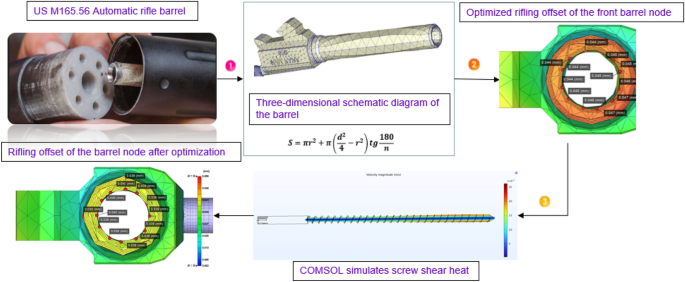Researchers have developed an innovative method to detect and optimize barrel rifling offsets using thin film in-mold decoration (IMD) technology. This breakthrough could significantly improve the accuracy and performance of automatic firearms like the US M165.56 rifle. By harnessing the unique properties of Polyetheretherketone (PEEK) film, the team has devised a way to precisely identify barrel rifling deviations and optimize the manufacturing process accordingly. This research holds immense potential for enhancing the reliability and safety of modern weapons systems.

Detecting Rifling Offsets with IMD Technology
In this groundbreaking study, researchers have leveraged the unique properties of PEEK material to develop a novel method for detecting and optimizing barrel rifling offsets. PEEK is a high-performance thermoplastic known for its exceptional thermal stability, chemical resistance, and mechanical strength – making it an ideal choice for in-mold decoration (IMD) applications.
The researchers proposed a nodal detection approach that utilizes the PEEK film’s die index, a measure of its unique deformation characteristics, to pinpoint the precise locations of barrel rifling deviations. By strategically applying the PEEK film to the barrel surface and analyzing the die index data, the team was able to accurately identify areas with large helix offsets, enabling targeted optimization of the manufacturing process.
Optimizing the Barrel Rifling Process
To achieve the desired rifling accuracy, the researchers employed a combination of theoretical analysis, numerical simulation, and experimental verification. They explored the impact of various injection molding parameters, such as holding time, filling time, and clamping force, on the barrel’s rifling characteristics.
Through steady-state simulations, the team investigated the effects of these parameters on fluid flow velocity, shear rate, temperature distribution, and phase transitions within the barrel. By considering the shear heating process of the injection screw, the researchers ensured the accuracy of the die index data, which ultimately guided the optimization of the barrel rifling design and production.
Enhancing Weapon Reliability and Safety
The findings of this study hold significant implications for the manufacturing of automatic firearms like the US M165.56 rifle. By optimizing the barrel rifling process and minimizing offsets, the researchers have paved the way for improved accuracy, reliability, and safety of these weapons.
Accurate barrel rifling is crucial for ensuring the consistent and predictable trajectory of bullets, which is essential for both military and law enforcement applications. The innovative use of PEEK film and IMD technology to detect and address rifling deviations represents a major step forward in the field of firearm engineering.
Furthermore, the researchers’ approach of combining theoretical analysis, numerical simulation, and experimental verification demonstrates the power of interdisciplinary collaboration in solving complex manufacturing challenges. This holistic methodology can be applied to the optimization of various other precision engineering processes, opening up new possibilities for the development of high-performance products across industries.
Author credit: This article is based on research by Hanjui Chang, Guangyi Zhang, Yue Sun, Shuzhou Lu.
For More Related Articles Click Here
